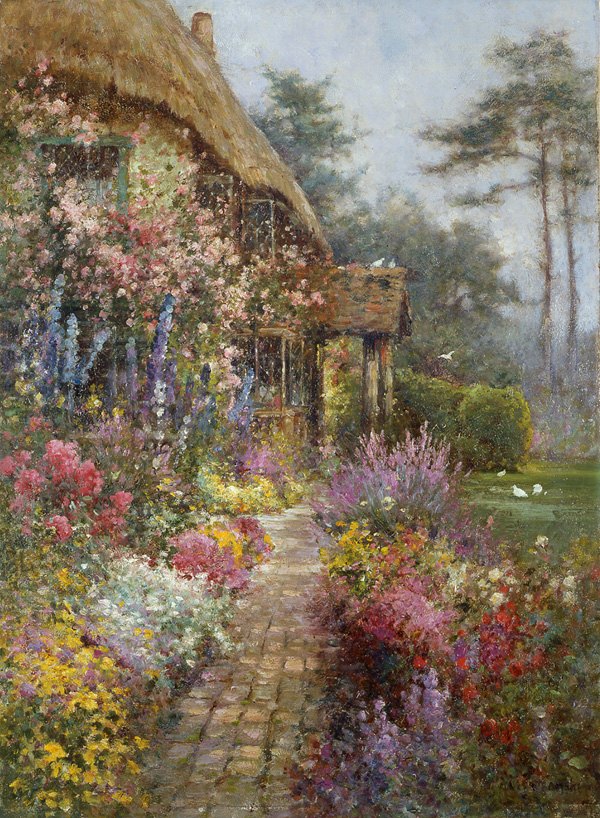Alfred de Breanski, Jr.
(1877 - 1957)
A Garden in July
Oil on canvas
21 1/2 x 16 inches
Signed
BIOGRAPHY - Alfred de Breanski, Jr. (1877 - 1957)
Alfred Fontville de Breanski was born into a family of painters. Not only was his father the highly regarded Victorian landscape painter, Alfred de Bréanski, Sr., but his mother was the Welsh painter, Annie Roberts. In addition, his uncle Gustave de Bréanski was a noted seascape painter, and his aunt Julie had also trained as an artist. Working as a painter, then, was something of a family business. Born in London in 1877, the young de Breanski was the oldest son in a family of seven children. Naturally, he began to study art early in life, training with his father and uncle along with his younger brother, Arthur. He then enrolled at St. Martins School of Art, the prestigious London institution now known as Central St. Martins College of Art and Design.
Because of his father’s work as a landscape painter, the family often traveled to Wales where the scenery was especially appealing—and of course, Annie Roberts de Bréanski’s family was there. This provided an opportunity for the children to test their abilities as landscape artists and to master the skills they would later need to establish their own careers. A. F. de Breanski’s early works are, unsurprisingly, in the style of his father—luminous naturalistic landscapes of Welsh mountains or Scottish Highlands.
Because of the similarity of their names, a note must be added about the signatures used by the elder and younger Alfred de Breanski. In general, the elder painter used his full name, including an accent aigu over the “é” in his last name, while his son did not. Alfred Jr. often signed his work as A. F. de Breanski, sometimes including “Jr.” after his last name; occasionally he also used A. Fontville rather than Breanski. The system wasn’t foolproof, but it did aid in clarifying which member of this talented family was the source of a particular painting.
By the 1890s, de Breanski ventured to France to “finish” his artistic education. There he met the elderly James McNeil Whistler and also explored the incredibly diverse arts community of belle époque Paris. The influence of this sojourn is evident in his increasingly Symbolist treatment of his characteristic landscapes, as in Evening at Loch Vennaeker where naturalism has evolved into a more abstract composition intended as a private meditative image. Simultaneously, he absorbed the Impressionist’s emphasis on unadulterated color and stenographic brushwork. Fishing Fleet in the Harbour, for example, owes a debt to the work of Alfred Sisley and Claude Monet in its concentration on the effects of light on water, and the clearly visible brushstrokes defining the scene.
On his return to London, de Breanski began to display his paintings at the annual metropolitan exhibitions, both at the Royal Academy and at the Royal Society of British Artists, a more unbiased exhibition venue than the conventional Academy. Beginning in 1905, he enjoyed considerable success with a series of garden paintings, this time using an Impressionistic approach to technique to depict the traditional picturesque elements of English garden design. Included in this popular group of paintings at the Royal Academy exhibitions were: A Cottage Garden, 1907; Summer, 1912; Willows, 1914; and Autumn Gold, 1917. Although not documented as an intentional series on the theme of English gardens, it seems likely that de Breanski was influenced by the well-known series paintings produced by Monet beginning in the 1880s. In addition, Monet himself lived in London for brief periods in 1901 and 1904-05 while working on a series of paintings featuring the Thames River and the Houses of Parliament, a fact that was duly recorded in the local newspapers.
In large part because of the warm critical and popular reception of de Breanski’s garden paintings, he was approached by the Underground Electric Railways Company to design at least two posters for the new London transit system. Both of these 30 x 20 inch images were intended to remind Londoners that the beauty of parks, gardens and forests were readily accessible to everyone simply by hopping on the trams. Twickenham by Tram illustrates two swans in the foreground of a bucolic pond while modest slips for rowboats dot the shoreline in the distance; broad flat areas of golden ink and delicate cream-colored reflections suggest a bright sunny day in suburban Twickenham—surely a destination that all right-minded Londoners would want to explore. Likewise, Kew Gardens by Tram showcases the renowned botanical gardens there, spotlighting the water lilies in full bloom in the foreground.
Printed in 1915 by Johnson, Riddle & Company, Ltd., these decidedly art nouveau designs were posted on the front of buses and on the side panels of the new trams, thus reinforcing the concept that high quality art was not restricted to salons, academies and museums, but available to all people every day. With these posters, de Breanski positioned himself firmly in the modern movement of the early twentieth century, dedicated to unifying so-called “high art” with “commercial art,” very much in the spirit of the Parisian poster artists, Henri de Toulouse-Lautrec and Jules Chéret.
During the 1920s de Breanski continued to paint landscapes and garden images although by then his work began to seem somewhat old-fashioned. In more recent times, there has been a reassessment of his work as scholars begin to explore historical developments beyond the modernist canon.
Janet Whitmore, Ph.D.
Selected Museums
Government Art Collection, Department for Culture, Media and Sport, London
London Transport Museum
Watford Museum, Watford, UK

